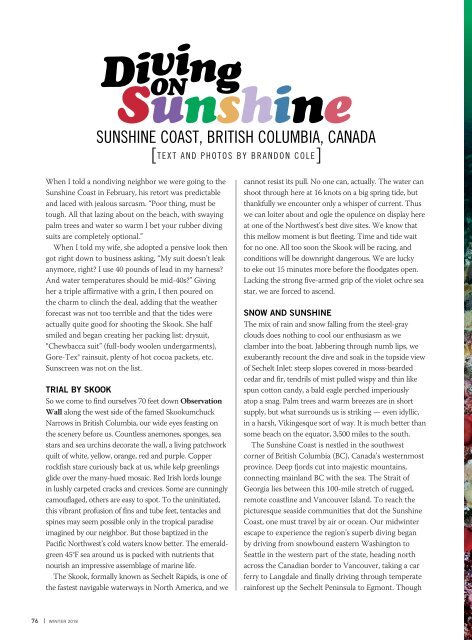AD 2018 Q1
Alert Diver is the dive industry’s leading publication. Featuring DAN’s core content of dive safety, research, education and medical information, each issue is a must-read reference, archived and shared by passionate scuba enthusiasts. In addition, Alert Diver showcases fascinating dive destinations and marine environmental topics through images from the world’s greatest underwater photographers and stories from the most experienced and eloquent dive journalists in the business.
Alert Diver is the dive industry’s leading publication. Featuring DAN’s core content of dive safety, research, education and medical information, each issue is a must-read reference, archived and shared by passionate scuba enthusiasts. In addition, Alert Diver showcases fascinating dive destinations and marine environmental topics through images from the world’s greatest underwater photographers and stories from the most experienced and eloquent dive journalists in the business.
Create successful ePaper yourself
Turn your PDF publications into a flip-book with our unique Google optimized e-Paper software.
Diving<br />
ON<br />
Sunshine<br />
SUNSHINE COAST, BRITISH COLUMBIA, CAN<strong>AD</strong>A<br />
TEXT AND PHOTOS BY BRANDON COLE<br />
When I told a nondiving neighbor we were going to the<br />
Sunshine Coast in February, his retort was predictable<br />
and laced with jealous sarcasm. “Poor thing, must be<br />
tough. All that lazing about on the beach, with swaying<br />
palm trees and water so warm I bet your rubber diving<br />
suits are completely optional.”<br />
When I told my wife, she adopted a pensive look then<br />
got right down to business asking, “My suit doesn’t leak<br />
anymore, right? I use 40 pounds of lead in my harness?<br />
And water temperatures should be mid-40s?” Giving<br />
her a triple affirmative with a grin, I then poured on<br />
the charm to clinch the deal, adding that the weather<br />
forecast was not too terrible and that the tides were<br />
actually quite good for shooting the Skook. She half<br />
smiled and began creating her packing list: drysuit,<br />
“Chewbacca suit” (full-body woolen undergarments),<br />
Gore-Tex® rainsuit, plenty of hot cocoa packets, etc.<br />
Sunscreen was not on the list.<br />
TRIAL BY SKOOK<br />
So we come to find ourselves 70 feet down Observation<br />
Wall along the west side of the famed Skookumchuck<br />
Narrows in British Columbia, our wide eyes feasting on<br />
the scenery before us. Countless anemones, sponges, sea<br />
stars and sea urchins decorate the wall, a living patchwork<br />
quilt of white, yellow, orange, red and purple. Copper<br />
rockfish stare curiously back at us, while kelp greenlings<br />
glide over the many-hued mosaic. Red Irish lords lounge<br />
in lushly carpeted cracks and crevices. Some are cunningly<br />
camouflaged, others are easy to spot. To the uninitiated,<br />
this vibrant profusion of fins and tube feet, tentacles and<br />
spines may seem possible only in the tropical paradise<br />
imagined by our neighbor. But those baptized in the<br />
Pacific Northwest’s cold waters know better. The emeraldgreen<br />
45°F sea around us is packed with nutrients that<br />
nourish an impressive assemblage of marine life.<br />
The Skook, formally known as Sechelt Rapids, is one of<br />
the fastest navigable waterways in North America, and we<br />
cannot resist its pull. No one can, actually. The water can<br />
shoot through here at 16 knots on a big spring tide, but<br />
thankfully we encounter only a whisper of current. Thus<br />
we can loiter about and ogle the opulence on display here<br />
at one of the Northwest’s best dive sites. We know that<br />
this mellow moment is but fleeting. Time and tide wait<br />
for no one. All too soon the Skook will be racing, and<br />
conditions will be downright dangerous. We are lucky<br />
to eke out 15 minutes more before the floodgates open.<br />
Lacking the strong five-armed grip of the violet ochre sea<br />
star, we are forced to ascend.<br />
SNOW AND SUNSHINE<br />
The mix of rain and snow falling from the steel-gray<br />
clouds does nothing to cool our enthusiasm as we<br />
clamber into the boat. Jabbering through numb lips, we<br />
exuberantly recount the dive and soak in the topside view<br />
of Sechelt Inlet: steep slopes covered in moss-bearded<br />
cedar and fir, tendrils of mist pulled wispy and thin like<br />
spun cotton candy, a bald eagle perched imperiously<br />
atop a snag. Palm trees and warm breezes are in short<br />
supply, but what surrounds us is striking — even idyllic,<br />
in a harsh, Vikingesque sort of way. It is much better than<br />
some beach on the equator, 3,500 miles to the south.<br />
The Sunshine Coast is nestled in the southwest<br />
corner of British Columbia (BC), Canada’s westernmost<br />
province. Deep fjords cut into majestic mountains,<br />
connecting mainland BC with the sea. The Strait of<br />
Georgia lies between this 100-mile stretch of rugged,<br />
remote coastline and Vancouver Island. To reach the<br />
picturesque seaside communities that dot the Sunshine<br />
Coast, one must travel by air or ocean. Our midwinter<br />
escape to experience the region’s superb diving began<br />
by driving from snowbound eastern Washington to<br />
Seattle in the western part of the state, heading north<br />
across the Canadian border to Vancouver, taking a car<br />
ferry to Langdale and finally driving through temperate<br />
rainforest up the Sechelt Peninsula to Egmont. Though<br />
76 | WINTER <strong>2018</strong>









